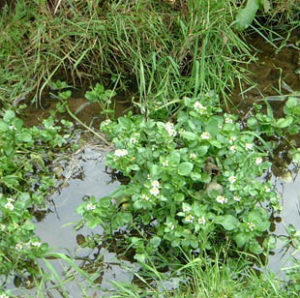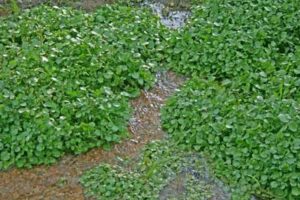WATERCRESS – THE SPRING BOUNTY OF THE FOREST STREAMS
TODAY’S LESSON: In our not too distant past, the first harvest emerging as the snow melted was wild watercress foraged from brisk running forest streams. It was a refreshing, nutrient-rich, ingredient in salads and creatively captured in sauces or even sautéed until wilted like spinach. Today we will unleash its peppery flavor into a beautiful sauce with the richness of the emerging Spring salmon.
 WHAT EXACTLY IS WATERCRESS? Watercress is a rapidly growing aquatic and semi-aquatic perennial herb with bushy, rounded dark green leaves and succulent hollow stems, botanically named Nasturtium officinale-aquaticum. Watercress has a pungent, peppery, mustardy, and slightly bitter flavor. Commonly watercress is used as a garnish for soups, salads, and sandwiches.
WHAT EXACTLY IS WATERCRESS? Watercress is a rapidly growing aquatic and semi-aquatic perennial herb with bushy, rounded dark green leaves and succulent hollow stems, botanically named Nasturtium officinale-aquaticum. Watercress has a pungent, peppery, mustardy, and slightly bitter flavor. Commonly watercress is used as a garnish for soups, salads, and sandwiches.
WHERE DOES WATERCRESS COME FROM? Watercress is native to Europe and America and also can be found growing throughout the United States, and Canada. It is one of the oldest known leaf plants consumed by humans. Watercress can be found growing in shallow, slow-moving creeks, streams and springs in the wild.
There are potential drawbacks from consuming the tender young watercress found in these “wild” locations as impurities or pollutants in the water are transferred to the plant itself and ingested upon consumption.
 Commercially grown watercress is typically grown in soil rather than water. Only the roots are kept saturated and fed nutrients that will produce a crop every six weeks in winter and every three weeks in summer. Hydroponics, the means of growing plants on water, is also perfect for the production of watercress. The plants are fed nutrients through the water under controlled conditions. Additionally, the water is carefully monitored to control levels of bacteria and other impurities.
Commercially grown watercress is typically grown in soil rather than water. Only the roots are kept saturated and fed nutrients that will produce a crop every six weeks in winter and every three weeks in summer. Hydroponics, the means of growing plants on water, is also perfect for the production of watercress. The plants are fed nutrients through the water under controlled conditions. Additionally, the water is carefully monitored to control levels of bacteria and other impurities.
ADVANTAGES: Watercress leaves provide great flavor and are high in vitamin A, calcium and potassium.
SELECTING YOUR WATERCRESS: Select your source carefully and treat raw wild watercress by soaking it in Halazone tablets (available at most drug stores) to kill bacteria before eating. For commercial watercress, select deep green leaves on crisp, slender stems. Watercress deteriorates quickly so be picky. Avoid wilted, browning or yellowish leaves. Refrigerate watercress in a plastic bag, but use it immediately. If you plan to store it longer than a day, cover it with damp paper towels and stick the stems in a few ice cubes before refrigerating. Drain the water daily and refresh with more ice. The watercress should last for three or four days using this technique.
PREPARING YOUR WATERCRESS: Watercress is one of the easiest of the family of greens to prepare after washing. Simply twist off the lower third of the stem ends. The stems are edible but a little coarse compared to those tender delicate leaves.
TRICKS OF THE TRADE: For easy chopping, use the stems as a handle. Hold the lower, coarser third of the stem and cut the remaining prime leaves and stems with your knife. Remember, when cooking, add the watercress at the last second so it just wilts, to capture the spicy flavor.
OUR SAUCE BEGINS: Start by sautéing shallots in a little butter over medium heat. As they become tender add the white wine, cooking until reduced by half the original volume. Add the heavy cream, returning to a simmer. Cook until the sauce has reduced to coat the back of a spoon. Transfer the sauce to a blender. Add the watercress. Carefully puree until smooth in a blender(see note in recipe). Transfer to a fine sieve to strain into another saucepan. Season as necessary. Keep warm it is ready to serve.
MIX AND MATCH: You can spunk up the basic sauce with a handful of capers, a few chiles and even a boost of grained mustard for additional kick.
TRY YOUR TECHNIQUE: Try my favorite dish of the Spring season, Roasted Salmon with Watercress-Pinot Gris Sauce.
PAN ROASTED SALMON WITH WATERCRESS-PINOT GRIS SAUCE
Makes 4 servings
4 filets of salmon, skin on about 6 ounces each (skin optional)
sea salt, prefer pink
freshly ground black pepper
olive oil or red palm fruit oil
2 tablespoons shallots, minced
4 bunches of watercress, for sautéing
1 recipe Watercress-Pinot Gris Sauce (recipe follows)
1 bunch of watercress, lower stems removed tops picked into little sprigs for garnish
Preheat your oven to 425 degrees F.
In a large skillet, heat over high heat until hot. Rub a few drops of oil on the skin of the salmon, then place the skin side down into the skillet, cooking until well seared about 3 minutes. Season the upright meat of the fish with salt and pepper. Transfer the skillet to the oven to finish cooking, about 4 minutes to medium rare, depending on the thickness of the filets.
While the salmon is in the oven, in a large skillet over high heat, add 1 tablespoon of olive oil and the shallots, cooking for 1 minute. Add the 4 bunches of watercress, cooking to wilt and reduce liquids to coat. Season well with salt and pepper. Divide and position the wilted watercress in the center warm coupe style plates.
As the salmon finishes, carefully remove the hot skillet from the oven. Immediately position the salmon filets, skin side atop the wilted watercress. Drizzle the over the salmon. In a medium bowl combine the watercress springs and a few drops of the olive oil to lightly coat, seasoning lightly with salt and pepper. Position the springs atop the salmon filets. Serve immediately of course with a glass of Elk Cove Pinot Gris.

WATERCRESS-PINOT GRIS SAUCE
Makes 4 servings
1 tablespoon unsalted butter
1/2 cup sliced shallots
1 cup Elk Cove Pinot Gris or dry Sauvignon Blanc white wine
1 cup heavy cream
sea salt to taste
freshly ground white pepper to taste
1 bunch fresh watercress, the lower third of stems removed
In a medium-size saucepan, melt the butter over high heat. Add the shallots and sauté until tender, about 3 minutes. Add the Chardonnay and cook until reduced by half, about 8 minutes. Add the cream and cook until thickened to coat the back of a spoon, about 8 minutes. Remove from the heat and adjust the seasoning with salt and
pepper as necessary.
When ready to serve, reheat the sauce to a short boil. Transfer to a blender adding the watercress. Place the lid on the blender and leave the vent open. For safety place a kitchen towel over the top of the open vent blender top to prevent any hot liquid from splashing out while letting the hot air and steam from the sauce to escape. Puree on high speed until smooth. Serve immediately to maintain the bright color and flavor of the sauce.
Jimmy Schmidt